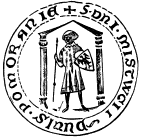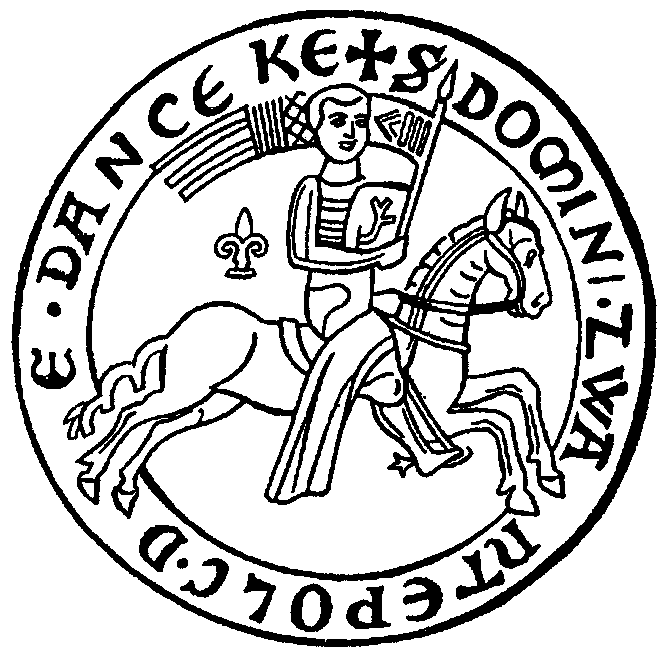|
Teutonic Takeover Of Danzig (Gdańsk)
The city of Danzig (Gdańsk) was captured by the State of the Teutonic Order on 13 November 1308, resulting in a massacre of its inhabitants and marking the beginning of tensions between Poland and the Teutonic Order. Originally the knights moved into the fortress as an ally of Poland against the Margraviate of Brandenburg. However, after disputes over the control of the city between the Order and the King of Poland arose, the knights murdered a number of citizens within the city and took it as their own. Thus the event is also known as Gdańsk massacre or Gdańsk slaughter (''rzeź Gdańska''). Though in the past a matter of debate among historians, a consensus has been established that many people were murdered and a considerable part of the town was destroyed in the context of the takeover. In the aftermath of the takeover, the order seized all of Pomerelia (Gdańsk Pomerania) and bought up the supposed Brandenburgian claims to the region in the Treaty of Soldin (1309). The co ... [...More Info...] [...Related Items...] OR: [Wikipedia] [Google] [Baidu] |
Polish–Teutonic War
Polish–Teutonic War may refer to: * Teutonic takeover of Danzig (Gdańsk) (1308–1309) *Polish–Teutonic War (1326–1332) over Pomerelia, concluded by the Treaty of Kalisz (1343) *the Polish–Lithuanian–Teutonic War or ''Great War'' (1409–1411), ending the Lithuanian Crusade with the Peace of Thorn (1411) *the Hunger War (1414) over the border in Samogitia *the Gollub War (1422) over the border in Samogitia, ending with the Treaty of Melno *Polish–Teutonic War (1431–1435), part of the Lithuanian Civil War * Thirteen Years' War (1454–1466) or War of the Cities, a Polish-backed revolt of western Prussian cities against Teutonic rule *War of the Priests (Poland) (1467–1479), contesting the election of the Bishop of Warmia *Polish–Teutonic War (1519–1521) The Polish–Teutonic War of 1519–1521 (german: Reiterkrieg, lit=Knight's War, pl, Wojna pruska, lit=Prussian War) was fought between the Kingdom of Poland and the Teutonic Knights, ending with the Comp ... [...More Info...] [...Related Items...] OR: [Wikipedia] [Google] [Baidu] |
King Of Poland
Poland was ruled at various times either by dukes and princes (10th to 14th centuries) or by kings (11th to 18th centuries). During the latter period, a tradition of free election of monarchs made it a uniquely electable position in Europe (16th to 18th centuries). The first known Polish ruler is Duke Mieszko I, who adopted Christianity under the authority of Rome in the year 966. He was succeeded by his son, Bolesław I the Brave, who greatly expanded the boundaries of the Polish state and ruled as the first king in 1025. The following centuries gave rise to the mighty Piast dynasty, consisting of both kings such as Mieszko II Lambert, Przemysł II or Władysław I the Elbow-high and dukes like Bolesław III Wrymouth. The dynasty ceased to exist with the death of Casimir III the Great in 1370. In the same year, the Capetian House of Anjou became the ruling house with Louis I as king of both Poland and Hungary. His daughter, Jadwiga, later married Jogaila, the pagan Grand ... [...More Info...] [...Related Items...] OR: [Wikipedia] [Google] [Baidu] |
Treaty Of Arnswalde
The Treaty of Arnswalde (''Treaty of Choszczno'') was signed on 1 April 1269 between three Brandenburgian margraves, the Ascanians John II, Otto IV and Conrad, and Duke Mestwin II of Pomerelia (Mściwój II) in Arnswalde (then a fortified place in the Brandenburgian New March, now Choszczno, Poland). With the treaty, Mestwin gave some of his possessions to the margraves, and had them returned as a fief. Excluded from the return was the Białogard (Belgard) area, including Świecie (Schwetz), which remained under direct Brandenburgian rule. In turn the margraves financed the duke, e.g. for the marriage of Mestwin's daughter Catherine with Pribislaw II of Parchim-Richtenberg (part of Mecklenburg). Through this treaty, Brandenburg gained direct access to the Baltic Sea. The signing of the treaty provoked a rebellion by the nobility of the region who were opposed to the Brandenburgians. Likewise, Mestwin's brother Warcisław of Gdańsk (Danzig), and his uncle, Sambor II took ... [...More Info...] [...Related Items...] OR: [Wikipedia] [Google] [Baidu] |
Mestwin II, Duke Of Pomerania
Mestwin II ( pl, Mściwój II or ''Mszczuj II'') ( 1220 – December 25, 1294) was a Duke of Pomerelia, member of the Samborides dynasty. He ruled Pomerelia as a sole ruler from 1273 to 1294. Early life Mestwin II was the son of Swietopelk II and the Přemyslid dynasty princess Eufrozyna. As a young man, in 1243 he was taken into the Teutonic Order custody as a hostage, part of the ceasefire agreement between his father and the Order, but the Order did not keep their part of this agreement and failed to return Mestwin II who was held by them until 1248 (for some time in the Order castle in Austria) when finally released. Acquiring power Most likely upon returning from Teutonic Order captivity his father made Mestwin II the Duke of Świecie (Schwetz) province circa 1250, and upon his father's death he began his challenge against his younger brother for Gdańsk (Danzig) in 1266, starting the so-called Pomerelian Civil War that lasted until 1273. He fought his younger brother an ... [...More Info...] [...Related Items...] OR: [Wikipedia] [Google] [Baidu] |
Swietopelk II
Swietopelk II, also Zwantepolc II or Swantopolk II, (1190/1200 – 11 January 1266), sometimes known as the Great ( pl, Świętopełk II Wielki; Kashubian: ''Swiãtopôłk II Wiôldżi''), was the ruling Duke of Pomerelia-Gdańsk from 1215 until his death. He was the first member of the Samborides to style himself ''dux'' from 1227 onwards.Loew PO: Danzig. Biographie einer Stadt, Munich 2011, p. 32: "Sambor ..styled himself 'princeps Pomoranorum,' .. but not 'dux,' which was the privilege of the Piasts." p. 33: "After Sambor's death ..his brother Mestwin ..strove after gaining ever greater independence from Poland. He confidently styled himself 'princeps in Danzk' and expanded southwards. His oldest son Swantopolk (Swietopelk), ruling from 1217 onwards, exploited Poland's fragmentation to acquire independence for his realm; already since 1227 he styled himself 'dux,' 'Duke of Pomerelia.'" Names The duke is known under many spellings (''Swantepolk, Swantipolk, Svatopluk, Sw ... [...More Info...] [...Related Items...] OR: [Wikipedia] [Google] [Baidu] |
Swietopelk II Of Pomerania
Swietopelk II, also Zwantepolc II or Swantopolk II, (1190/1200 – 11 January 1266), sometimes known as the Great ( pl, Świętopełk II Wielki; Kashubian: ''Swiãtopôłk II Wiôldżi''), was the ruling Duke of Pomerelia-Gdańsk from 1215 until his death. He was the first member of the Samborides to style himself ''dux'' from 1227 onwards.Loew PO: Danzig. Biographie einer Stadt, Munich 2011, p. 32: "Sambor ..styled himself 'princeps Pomoranorum,' .. but not 'dux,' which was the privilege of the Piasts." p. 33: "After Sambor's death ..his brother Mestwin ..strove after gaining ever greater independence from Poland. He confidently styled himself 'princeps in Danzk' and expanded southwards. His oldest son Swantopolk (Swietopelk), ruling from 1217 onwards, exploited Poland's fragmentation to acquire independence for his realm; already since 1227 he styled himself 'dux,' 'Duke of Pomerelia.'" Names The duke is known under many spellings (''Swantepolk, Swantipolk, Svatopluk, Sw ... [...More Info...] [...Related Items...] OR: [Wikipedia] [Google] [Baidu] |
Lübeck City Rights
Lübeck (; Low German also ), officially the Hanseatic City of Lübeck (german: Hansestadt Lübeck), is a city in Northern Germany. With around 217,000 inhabitants, Lübeck is the second-largest city on the German Baltic coast and in the state of Schleswig-Holstein, after its capital of Kiel, and is the 35th-largest city in Germany. The city lies in Holstein, northeast of Hamburg, on the mouth of the River Trave, which flows into the Bay of Lübeck in the borough of Travemünde, and on the Trave's tributary Wakenitz. The city is part of the Hamburg Metropolitan Region, and is the southwesternmost city on the Baltic, as well as the closest point of access to the Baltic from Hamburg. The port of Lübeck is the second-largest German Baltic port after the port of Rostock. The city lies in the Northern Low Saxon dialect area of Low German. Lübeck is famous for having been the cradle and the ''de facto'' capital of the Hanseatic League. Its city centre is Germany's mo ... [...More Info...] [...Related Items...] OR: [Wikipedia] [Google] [Baidu] |
Piast
The House of Piast was the first historical ruling dynasty of Poland. The first documented Polish monarch was Duke Mieszko I (c. 930–992). The Piasts' royal rule in Poland ended in 1370 with the death of king Casimir III the Great. Branches of the Piast dynasty continued to rule in the Duchy of Masovia and in the Duchies of Silesia until the last male Silesian Piast died in 1675. The Piasts intermarried with several noble lines of Europe, and possessed numerous titles, some within the Holy Roman Empire. The Jagiellonian kings after John I Albert were also descended in the female line from Casimir III's daughter. Origin of the name The early dukes and kings of Poland are said to have regarded themselves as descendants of the semi-legendary Piast the Wheelwright (''Piast Kołodziej''), first mentioned in the '' Cronicae et gesta ducum sive principum Polonorum'' (Chronicles and deeds of the dukes or princes of the Poles), written c. 1113 by Gallus Anonymus. However, the t ... [...More Info...] [...Related Items...] OR: [Wikipedia] [Google] [Baidu] |
Samborides
The Samborides () or House of Sobiesław () were a ruling dynasty in the historic region of Pomerelia. They were first documented about 1155 as governors (''princeps'') in the Eastern Pomeranian lands serving the royal Piast dynasty of Poland, and from 1227 ruled as autonomous princes until 1294, at which time the dynasty died out. The subsequent war for succession between the Polish Piast dynasty, the Imperial Margraviate of Brandenburg and the State of the Teutonic Order resulted in the Teutonic takeover of Gdańsk (Danzig) in 1308. Geography The dynasty's dominion, Pomerelia, roughly corresponded with the area of today's Pomeranian Voivodeship in northern Poland. The Samborides from 1227 used the Medieval Latin title ''dux Pomeraniae''; their Duchy of Pomerelia was therefore referred to as "Duchy of Pomerania", even though there was another Duchy of Pomerania to the west, ruled by the House of Griffins, who likewise bore the title "Dukes of Pomerania". In Polish usa ... [...More Info...] [...Related Items...] OR: [Wikipedia] [Google] [Baidu] |
Pomeranian Duchies And Dukes
This is a list of the duchies and dukes of Pomerania. Dukes of the Slavic Pomeranian tribes (All Pomerania) The lands of Pomerania were firstly ruled by local tribes, who settled in Pomerania around the 10th and 11th centuries. Non-dynastic In 1106, Pomerania is divided by his two older sons: Wartislaw, who founded the House of Pomerania and the Duchy of Pomerania, and Świętopełk I. After Swietopelk's death, his lands were occupied by the Saxon prince Lothar of Supplinburg. In 1155, the lands regained independence under Sobieslaw I, who founded the dynasty of the Samborides, and the Duchy of Pomerelia. Duchy of Pomerania The Duchy resulted from the partition of Świętobor, Duke of Pomerania, in which his son Wartislaw inherited the lands that would become in fact known as ''Pomerania''. Partitions of Pomerania First partition 1155–1264 In 1155, Pomerania was divided in Pomerania-Szczecin and Pomerania-Demmin. In the struggle to shake off Polish and Danish cla ... [...More Info...] [...Related Items...] OR: [Wikipedia] [Google] [Baidu] |



